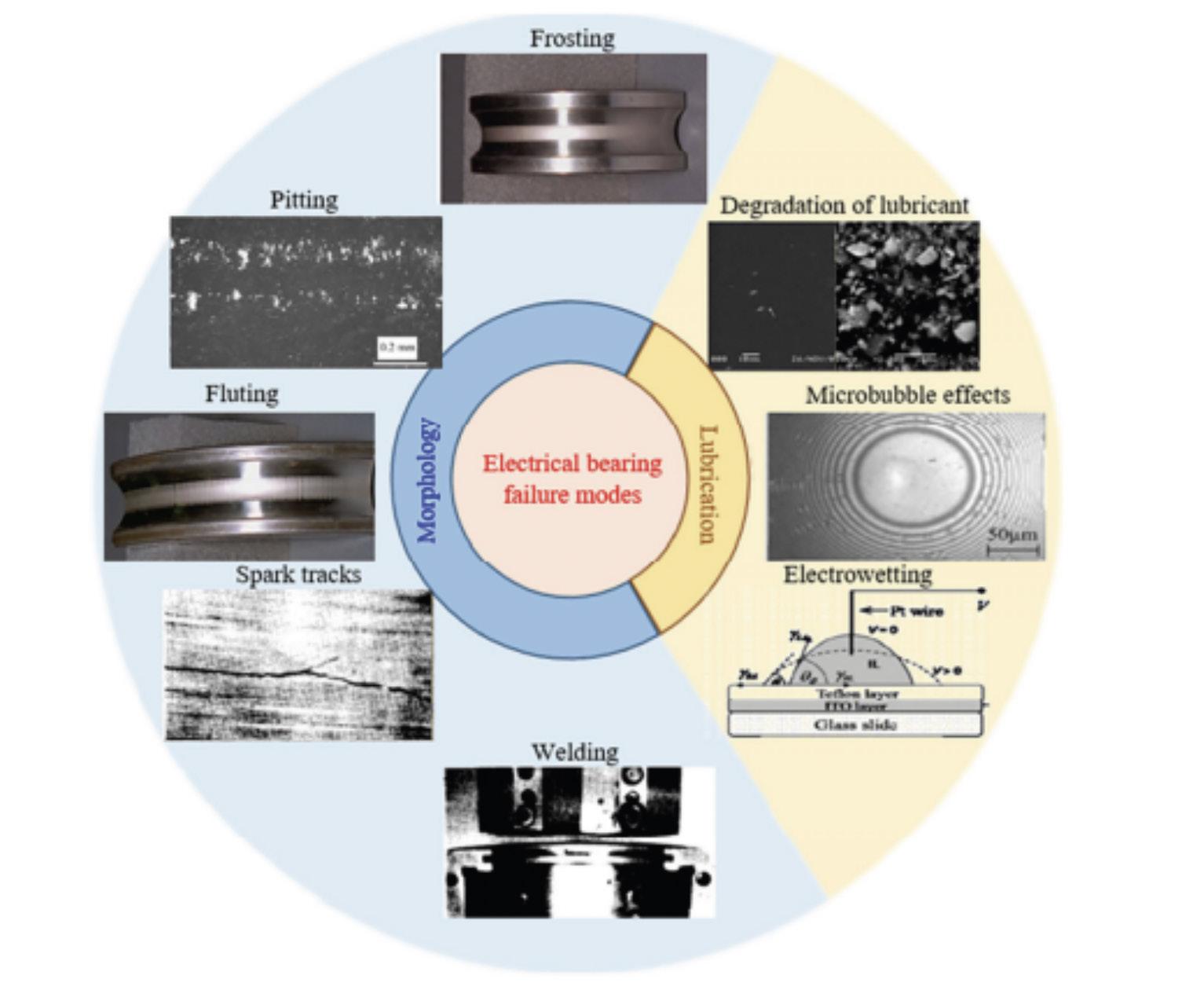
12 minute read
The NLGI Spokesman VALUE-ADD Recent Advances in Solving Grease Application Issues
Grease Knowledge
Industry Content
Supply Chain
Grease Education
Lubricating Grease
The NLGI Spokesman VALUE-ADD
Recent Advances in Solving Grease Application Issues
Dr. Raj Shah, Mr. Blerim Gashi
Despite the current wide range of grease lubricating applications (rolling bearings, plain type bearings, gears, joints, electric motors and vehicles, heavy duty machinery) there remains an evident lack of sufficient research aimed towards understanding the underlying mechanisms of film formation, loss of film, and film separation [1]. Instead, a majority of tribological research of grease lubrication focuses on overcoming challenges or shortcomings as a matter of application parameters (adjusting speed, temperature, or contact load) and the resulting performance outputs rather than the fundamental mechanisms governing the inputs.
Numerous tools can be utilized in order to enhance these property ranges and prevent lubrication failure, such as the incorporation of nanoadditives or polymer additives, as well as the improvement of oil distribution design, application frequency, and sealing performance in preventing contamination.
Recent advances focused in the last three years have extended the applicability of greases in extreme conditions. This article will summarize the key findings and lessons within those research advancements. Though these efforts have been fruitful, this area of research remains a vital field for yielding further mechanical performance and overall profits.
Grease Fundamentals
Grease lubrication is the process by which a semi-liquid lubricant coated on a wide-variety of contacting surfaces reduces the mechanical wear, coefficient of friction, and prevents premature failure of machinery. Fundamentally, greases are complex semi-liquid lubricants primarily consisting of a base oil (mineral or synthetic oil), a thickening agent (metal soap), and various viscosity modifiers and/or additives.
It is important to note that optimal utilization of greases relies on the correct type of grease used for specific requirements. The many types of greases consisting of various combinations of metal soap thickeners such as lithium, aluminum, sodium, or even clay contain a wide variety of temperature ranges, rust protection, and extreme pressure properties which are well understood [2]. Table 1 displays an assortment of some of the most common types of metal soaps utilized within industry today, as well as the key characteristics and applications of each respective thickener.
Thickener Key Characteristics Applications
Lithium Good lubricity, shear stability, Bearings in automotive and Soaps thermal resistance, low oil industrial applications separation Calcium Improved water resistance over the Used in applications up to 110 C, Soaps lithium greases, good shear bearings of water pump, wheel Stability bearing, and agricultural vehicles Sodium High dropping points (~ 175C), goodBearings in aerospace, wheel Soaps shear stability and lubricity bearings, universal joints, and axle journal boxes Aluminum Excellent oxidation resistance, good Vibrating screens, elevator drive Soaps water resistance motors and governors where reverse motion occurs, and large electric motors with bearings operating at high linear speeds Table 1. Common organic soap greases, relative tribological and physical properties and common applications [3]
Better Decision-making in Grease Selection
The most important concept in effectively applying greases is that there is no universal grease which is adaptable to all machinery environments, and so different greases are directly applicable to a select few number of applications. For example, calcium greases withhold exceptional water resistance, as the consistency or viscosity does not change too much upon exposure to water such as in a steel, sugar, or paper mill [3]. Meanwhile, sodium soaps are particularly susceptible to water contamination but are great alternatives for high temperature applications due to a dropping point of ~ 175C in addition to heavy machinery with characteristic shear stability [3].
Another type of grease rising in popularity are polyurea greases, which are characterized with high shearing stability, strong water resistance, and a dropping point of ~ 180C. A comparative study indicates that polyurea greases consist of superior lubrication and corrosion resistance as compared to the more popular lithium complex greases [4]. Nonetheless, the most effective method towards preventing application issues lies in enhancing the quality of specification and choosing the correct grease for the type of bearing, engine, motor, or conditions. Thereafter, additives may be employed to further improve grease properties such as dropping point, thermal resistance, rust inhibition, and wear resistance.
Further Understanding of Overheat Conditions
Among the application of greases in metal contacting surfaces such as rolling bearings, gears, joints, and couplings, there are numerous common symptoms of lubrication failure. Namely, overheating, rusting, formation of unwanted deposits at high temperatures, surface wear, and rough running each indicate a fault in the grease’s properties or method of lubrication which is causing failure [5].
Overheating of these contact surfaces can be a result of either over-packing the tribopairs or not providing enough lubrication. Over-packing or over-greasing is particularly detrimental when considering the initial stages by which grease lubrication occurs. In this churning stage, an excess of grease flow which is responsible for a peak in temperature creates a fully flooded lubricant film [6]. Even if excessive operational heat does not represent an immediate mechanical concern for the machinery, overheating can lead to a multitude of additional problems with lubrication including oxidation, reduction of film or viscosity, and grease leakage or hardening [5].
On the contrary, inadequate
lubrication frequency is an intuitive cause to overheating, as the starvation of proper lubrication increases metal to metal contact and thus produces further heat generation [7]. Therefore, the proper amount of grease must be retroactively determined and the effect of greasing frequency on machinery must be evaluated in order to circumvent these problems.
Higher Performance Lubrication Systems
Although the lubrication of separate parts such as rolling bearings, gears, joints, and couplings prove quite simple, the consistent incorporation of grease within a whole engine or motor while maintaining sufficient grease distribution can be quite challenging. This process can oftentimes require the design of an intricate lubrication apparatus employing special types of lubricating techniques including dip, injection, or spray lubrication, or even a hybrid combination of one or more techniques.
Dip lubrication has been shown to be most effective at speeds <20 ms-1 and establishes a thin coating of lubrication among a majority of parts within the engine [8]. Injection lubrication is a more precise technique much better suited for higher speeds of up to 250 ms-1, directly targeting parts of the engine or motor most susceptible to lubricant starvation and mechanical wear thereafter [8]. Spray lubrication is another notable technique employed with both ester gear oils and greases which have both shown increased gearbox efficiency than dip lubrication [9].
New Additive Technologies
Rather than altering the tribological properties of the grease by utilizing a different base oil than the conventional ones like standard synthetic or mineral oils, additives have proven to be exceptionally effective at improving numerous grease capabilities and overall applicability.
Firstly, the coefficient of friction of mineral oil upon the incorporation of spherical CuO nanoparticles at 0.2, 0.5, 1 wt.% with contact loading and speed ranges from 147-392 N and 0.5-1.5 ms-1 was reduced by 37.9%, 42.9%, and 14.6% [10]. Clearly, the increase of CuO concentration within the oil leads to a greater reduction of coefficient of friction up to a certain critical value. This result is due to the presence of agglomerated nanoparticles at higher nanoparticle concentrations, which can be decreased by utilizing certain surfactants such as oleic acid to establish steric stabilization greater than the electrostatic force between the nanoparticles [10].
The addition of other nanoparticles including ZnO, MoS2 [11], and WS2 [12] have each shown effects on numerous other oil properties such as antiwear performance and viscosity. Extending these improvements directly to greases presents similar improvements, such as reduced friction imposed during the addition of 0.5 wt.% TiO2 and 0.5wt.% graphene + TiO2 at 10 and 20 N, respectively [13].
As aforementioned, the presence of excessive heat can be a compounding problem for efficient lubrication of machinery, most often causing degradation of grease properties and leading to lubricant failure. As a result, the cooperation of tribological and nanoparticle research has recently focused on expanding the thermal capabilities of greases by incorporating various additives, especially for application in electric vehicles (EVs) [14]. One notable example involves the addition of both multi-walled carbon nanotubes (MWCNTs) and graphene nanosheets (GNS) in a 1:1 ratio at different concentrations to formulate a calcium nanogrease. Equipped with a dropping point apparatus, the researchers were able to increase the dropping point and thermal conductivity of the calcium nanogrease by 30 and 153%, respectively [15].
Opportunities in Electrical Vehicles
The advent of EV lubrication introduces a whole new set of relevant conditions, as lubricants will be exposed to high operation temperatures, high speeds, electric currents and fields, as well as copper parts commonly found EVs [14]. Figure 1 displays the wide variety of problems that can occur which lead to bearing failure in an EV [16].
Figure 1. Depiction of bearing failures: Frosting and fluting [17], pitting [18], degradation of lubricant [19], microbubble effect [20], electrowetting [21], spark tracks and welding [22]. Reproduced from [16].
An understanding of each of these failure modes has prompted the required improvement of electrical properties in greases, as each of these modes are particularly attributable to the presence of varying electrical current amplitudes and electric fields [16-22].
The most important tool towards solving enhancing the electrical properties of greases once again heavily relies on the effective incorporation of certain additives. For instance, the addition of functionalized multi-walled carbon nanotubes (f-MWCNTs) are especially promising, as the presence of a charged functional group can enhance the electrical conductivity of the nanogrease [23]. Specifically, f-MWCNTs functionalized with hydroxide resulted in resistivities as low as 22.4 Ωcm, which was a direct result of increased hydrogen bonding between water and the hydroxyl functional groups [23]. The electrical conductivity of polyurea greases have also been improved through the incorporation of TiNAg composite coatings and multilayer graphene additives.
Moving Forward
In conclusion, the fundamental solution towards solving grease issues first lies in choosing the correct type of grease for the specific environment. While certain greases may excel in lubricating heavy machinery amazing shear stability, the same results may not be found applying the same grease in a steel mill with constant water contamination. Once the correct grease is chosen, the grease must thereafter be applied in a matter such that it provides even distribution to vital parts of the machinery, and prevents both over-packing or starvation.
Finally, many applications such as thrust and rolling bearings, and especially electric motors require the incorporation of various additives to improve grease properties including extreme pressure, anti-wear, corrosion resistance, and electrical conductivity. Whether the additive is an organic framework or a nanoparticle,

QUALITY PERFORMS.



it must be fully compatible with the specific grease composition, especially the base oil, so as to provide proper dispersion and thus enhancements to grease properties. Establishing a grease formulation following these three steps ensures successful lubrication and prevention of lubrication failure.
About the authors
Dr. Raj Shah is a Director at Koehler Instrument Company in New York, where he has worked for the last 25 years. He is an elected Fellow by his peers at NLGI, STLE, and the Energy Institute.
A Ph.D in Chemical Engineering from The Penn State University (https://www.che.psu.edu/news-archive/2018/ alumni-spotlight-raj-shah.aspx) and a Fellow from The Chartered Management Institute, London, Raj just became one of the first folks in the USA to be qualified as a Chartered Petroleum Engineer with the Energy Institute. An adjunct professor at the Dept. of Material Science and Chemical Engineering at State University of New York, Stony Brook, Raj has over 400 publications and has been active in the industry for 3 decades.
More information on Raj can be found at https:// www.nlgi.org/nlgi-veteran-member-raj-shahpresented-with-numerous-honors-in-2020/ Mr. Blerim Gashi is a student of Chemical engineering at SUNY, Stony Brook University, where Dr. Shah is the chairman on the external advisory board of directors, and Blerim is currently part of the thriving internship program at Koehler Instrument Company, in Long Island, NY.
LANXESS offers new premium Hybrid Salicylate additive technology with multi-functional performance including superior corrosion resistance. Designed for use in a range of grease types and base oils and across applications in demanding and extreme environments.
lab.lanxess.com

® = registered trademark of LANXESS Deutschland GmbH or its affiliates. Registered in many countries of the world.
References
[1] P. M. E. Cann. Trib. Series, 33, 573–581 (1996) doi:10.1016/s0167-8922(08)70819-8 [2] M.J. Neale, C4—Greases. In The Tribology Handbook, 2nd ed.; Butterworth-Heinemann: Oxford, MA, USA, 1995; pp. C4.1–C4.4. [3] Choosing the Right Grease Thickening System. (n.d.). Retrieved from https://www.nyelubricants. com/choosing-the-right692 grease-thickeningsystem. [4] Gaunlin Ren et al. Friction. 9. 1-18. 10.1007/ s40544-019-0325-z. (2019).
[5] H.D. Moore et al. Proc. of the Inst. of Mech. Eng., Conference Proceedings, 184(6), 74–81. doi:10.1243/ pime_conf_1969_184_146_02 (1969). [6] P. M. Lugt, Trib, Transactions, 52:4, 470-480. (2009). doi: 10.1080/10402000802687940 [7] Munehiro Hoshino. Theory of Grease Lubrication. Japanese Journ. of Trib.. 47. 13-23. (2202). [8] Bernd Morhard et al., Forschung auf dem Gebiete des Ingenieurwesens. 85. 10.1007/s10010-020-004230. (2021). [9] Heli Liu et al., Mechan. and Mach. Theory. 145. (2020). 10.1016/j.mechmachtheory.2019.103701. [10] Ahmed A Abdel-Rehim et al., Lub.. 9. (2021). 10.3390/lubricants9020016. [11] Seyed Borhan Mousavi et al., Sci. Rep.. (2020). 10. 10.1038/s41598-020-62830-1. [12] Ningning Hu et al., Mat. 13. 1522. (2020). 10.3390/ma13071522. [13] Jankhan Patel et al., App. Sci.. 9. 1629. (2019). 10.3390/app9081629. [14] Raj Shah et al., Lub. 9. 40. (2021). 10.3390/lubricants9040040. [15] A. Mohamed et al., Jour. of Mat. Res. and Tech. 9(3), (2020). doi:10.1016/j.jmrt.2020.04.020 [16] Feng He et al., Friction. 8. 4-28. (2020). 10.1007/s40544-019-0356-5. [17] H. E. Boyanton et al., IEEE Ind. App. Mag., 8(5), 53-57. (2002). doi: 10.1109/MIA.2002.1028391. [18] Kenji Sunahara et al., Trib. Transac. 54. 730-735. (2011). 10.1080/10402004.2011.597543. [19] Zhi-Qiang Yu et al., Journ. of Fail. Anal. and Prev. 11. 158-166. (2011). 10.1007/s11668-010-9422-z. [20] Guoxin Xie et al., Trib. Lett. 29. 169-176. (2008). 10.1007/s11249-007-9288-8. [21] Nanayakkara Y. S. Nanayakkara et al., Anal. Chem. 15;82(8):3146-54. (2010). doi: 10.1021/ ac9021852. PMID: 20349933. [22] M. J. Costello. IEEE Trans. on Ind. App.. 29(2). 419-426. (1993). doi: 10.1109/28.216553. [23] Greg Christensen et al., Synth. Met.. 268. 116496. (2020). 10.1016/j.synthmet.2020.116496.
SQM LITHIUM RACING TO PRODUCE A SUSTAINABLE AND STEADY
WWW.SQMLITHIUM.COM








